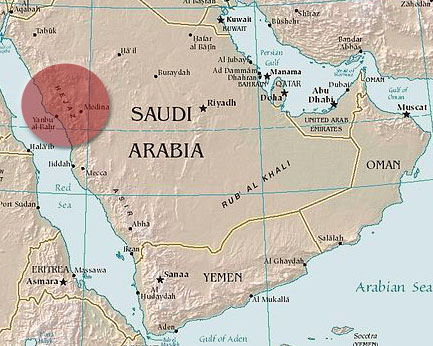Hejaz
The Hejaz (Arabic al - Hijaz الحجاز, DMG al - Ḥiǧāz ) is a landscape in western Saudi Arabia.
Entry into parts of the Hejaz ( the cities of Mecca and Medina and its surroundings ), Muslims are reserved.
Geography
The landscape Hejaz is about 300,000 square kilometers and includes the northwestern part of the Arabian Peninsula to about the Yemeni highlands, in recent times often only up to the limit of the landscape ʿ Asīr.
To the north of the Hejaz is demarcated clearly not called against the shame ( Greater Syria with Jordan and Palestine) region. In the west, the Red Sea forms a natural boundary.
At the height of Wādī Hamadh the landscape Midian, which is often not counted as actual Hejaz and extending to ʿ Aqaba begins. The dry coastal plain of Tihama is also often not recognized as Hijaz. The boundary east to the Nejd ( ie Nejd highlands ) is less clear.
The geology, climate
From the coast of the Red Sea the mountain rises to 2,446 m, and then drops slowly to the east. Precipitation varies from year to year and reach a maximum of 600 mm. On average, depending on the altitude, mostly between 100 and 300 mm. On the coast it is very humid in the summer.
Structure
The historic landscape Hejaz corresponds There are no administrative unit in Saudi Arabia.
Population
In the Hejaz over six million people, mostly Sunni Arabs live. Among the Arab population of the region is Ḥiǧāzi, a peculiar dialect of Arabic spread. The most important cities are Mecca, Medina, Jeddah, Taif, Tabuk, Yanbu al - Wadschh and Rabigh. Large economic significance of the pilgrimage of Muslims to the holy sites of Mecca and Medina.
Economy
Due to the desert climate only Bedouin economy and in a few oases agriculture is possible. Trade traditionally plays an important role. The annual pilgrimage ( Hajj ) is an important economic factor.
History
The Hejaz was in the 7th century under Mohammed the starting point of Islam, which expanded after the establishment of the caliphate across much of the Middle East and North Africa. However, the country lost very soon its political significance, as the Umayyad 661 their residence relocated to Damascus. In the following centuries the Hejaz was mostly from Egypt dominated (including Fatimid, Ayyubid, Mamluk ), to 1517, the Ottomans took control. However, the supremacy often more formal nature was (see also Eyalet ).
More significant were the ruling in Mecca sharif the Hashemites. Hussain ibn Ali I. ( Sherif of Mecca since 1908 ) began during the First World War in 1916 with the uprising against the Ottomans, where he was supported by Lawrence of Arabia and the UK. However, the promises of Great Britain as to the establishment of an Arab kingdom after the war were not met. Also known as King of the Hejaz (1916-1924) Hussain could not hold out against the Wahhabis and Ibn Abd al- Aziz Saud. In 1926 the Kingdom of Hejaz was combined with the Najd and 1932 part of the Kingdom of Saudi Arabia.








